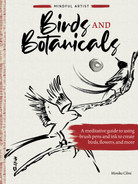Tools & Materials

You can find all of the tools and materials for this book by searching online for Asian art supplies. Some of the pens are also available from local art suppliers.
In this book, I mostly use Japanese brush pens, but you can also create the projects using traditional brush and ink, as in the tradition of “The Four Treasures.”

Brush Pens
The brush pen is a modern Japanese invention officially called fudepen, which in Japanese means “calligraphy brush.” These brush pens work almost identically to small ink brushes and can be used for most of the same purposes.
The fudepen is designed for calligraphy and consists of a pen nib with an ink reservoir that mimics the brushlike quality of the ink brush. The ink is designed to adhere well to modern paper, so you can use this pen on different types of paper.
Fudepens have gained popularity among artists who choose them over traditional brushes.
Here are the pens I’ve used in this book:
- Pentel®
- Sakura® brush pen
- Tombow® fudenosuke
- Japanese calligraphy pen with ink refill
When you buy brush pens, look for these specific Japanese brands because they are built for calligraphy and are remarkably close to a traditional brush. There are various good brands and you cannot go wrong with a fudenosuke brush pen.
Sakura also makes colored brush pens, which have lovely, vibrant colors—but you can also use other watercolor brush pens. I’ve used Stationary Island® brush pens in some projects.





Paper
You can use various types of paper with brush pens. In this book, I’ve used Canson® 180gsm heavyweight cartridge paper and a Faber-Castell® 140gsm watercolor pad. You can use any other similar paper or a different brand, but make sure the paper isn’t too grainy.

Traditional Tools
If you decide to work with traditional sumi-e (Japanese ink painting) tools, here is what you will need.
INK Traditional ink comes in sticks that you can grind yourself using an ink stone. They are made with oil soot or pine soot. You can also find liquid ink in bottles, but many professionals find it less rewarding in terms of the effects that they create. I also believe that the process of grinding an ink stick brings you closer to the mindful approach, and it can be a great ritual.
PAPER Traditionally, various types of paper are used, but most of it is handmade. As a beginner, you can start with machine-made paper, though. I suggest paper made from rice, mulberry, or bamboo.
BRUSHES These should be strictly Asian, not Western. They are made with animal hair, such as goat, horse, deer, sheep, weasel, and a mixture. I advise you to buy a good-quality brush that will last a long time, as it will make a difference in your work. You can start with a medium-sized one.

